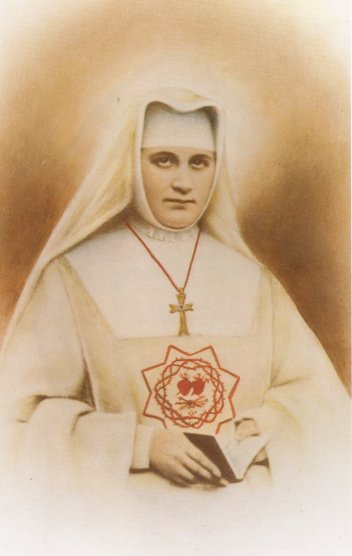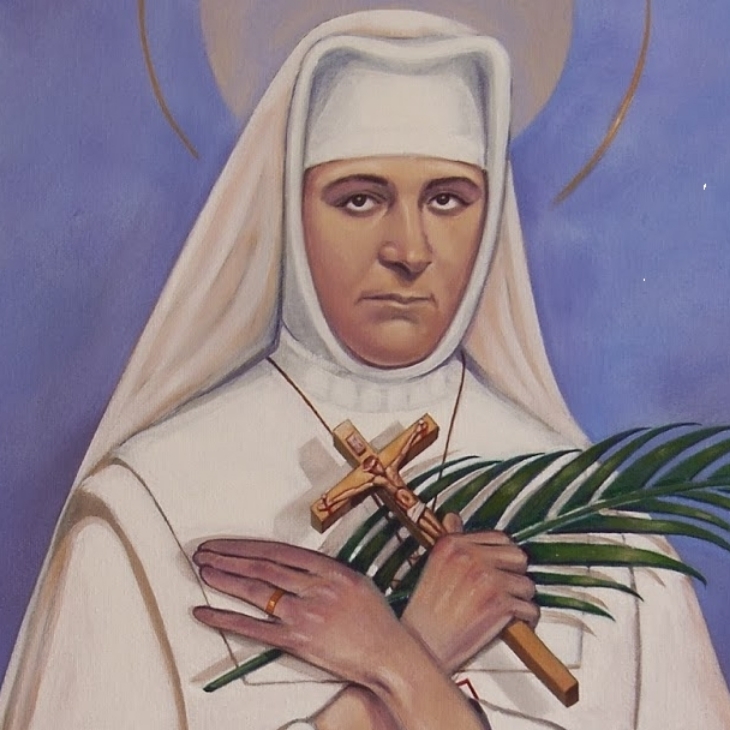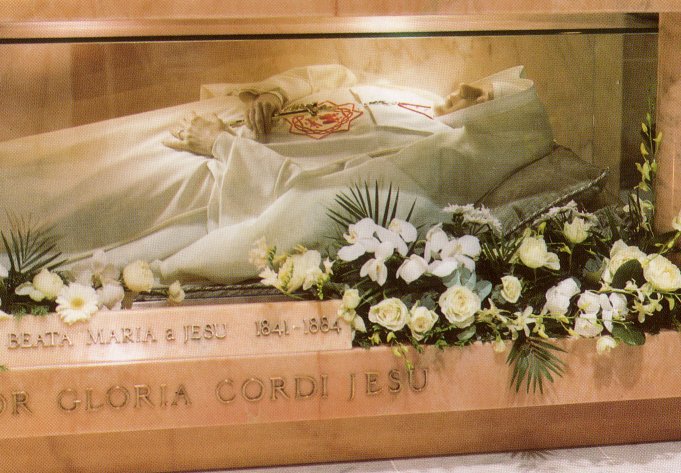Blessed Mary of Jesus Deluil-Martiny

May 28, 1841 - February 27, 1884
Founder of the Congregation of the Daughters of the Sacred Heart of Jesus
Feastday: February 27
Maria Deluil-Martiny was born in Marseille on May 28, 1841, the eldest of five children. Her father was a lawyer in Marseille. From her father she inherited the noble bravery that made her overcome all difficulties in her life's path. From her mother she inherited a fervent faith and a great delicacy. The two sources of power in her life were the Sacred Heart and the Eucharist.
When Mary reached the age to make her First Communion (it must have been about 8 years old), her parents wanted to favor her with serious preparation for this great deed. They entrusted her to the religious of the Visitation of Marseille (boarding school). When she turned 12 and was about to make her First Communion, she became seriously ill so that she could not make her First Communion with her companions. It was therefore postponed, and it was on December 22, 1853, that she received her God alone for the first time. She was also alone to receive the Sacrament of Confirmation on January 29, 1854.
While playing, she had founded a small religious order "the oblates of Mary" as a child at the age of 14 to 15, complete with rule, novitiate and dedication. This order, however, was abolished from above when it was discovered. When Maria was 15 years old, she returned to her family to help her mother raise her younger sisters. Meanwhile, she traveled to Lyon with her parents and her younger sister Amélie. For health and family reasons, her parents decided to entrust Amélie's education to the religious of the Sacred Heart of the “Ferrandière” (boarding school). Her parents traveled on to Paris on this occasion while Maria stayed with her younger sister. But when they returned from Paris, Maria insisted that she stay at boarding school with her sister, which her parents agreed to. She was then 15 years old. Mary enjoyed a high intellectual and moral education here.
At the age of 17, she was forced to return home to assist her family. Before leaving Lyon, she was fortunate enough to attend a retreat, led by a Father Jesuit, who was decisive for her further vocation. In order to get even more supernatural light on her further life, she goes to Ars where she stays for two days to meet the well-known (now) holy pastor Jean Baptiste-Maria Vianney in the confessional. She then travels back to her family in Marseille.
In 1864, Maria Deluil-Martiny becomes "the first zealot" of the newly established guard of honor of Jesus' Sacred Heart, whose members dedicate a fixed hour of their own choosing to the Sacred Heart each day; she works with medals, booklets and pictures and a short song:
Form, all the undivided earth,
Jesus' guard of honour,
Surrounding him and singing
love for the Sacred Heart.
During a retreat in honor of his Hart in 1865, she was liberated from the anxiety under which she suffered. She collected from the works of Francis de Sales the parts where he writes about the Sacred Heart.

After a sermon on the Sacred Heart by Father Calage S.J. at the end of 1866, this father became her guide. In March 1867 Maria's youngest sister died, aged fifteen.
During a retreat that same year, she "joined the perpetual adoration of Jesus' Sacred Heart to worship through Him the Most Holy Trinity." Her thanksgiving after Communion was as follows: “I offered Jesus Christ to Himself and to the Most Holy Trinity (He had taught me that by letting me do it) as an offering alive in my soul, and since then I am no longer that Jesus but it is He who sacrifices Himself in me. For some time the Lord seems to have erected in my soul an altar, on which He offers Himself unceasingly to His Father and to the adorable Trinity. He apparently wants my soul to abide in uninterrupted adoration in His presence, contemplating only Him and joining me to the divine deeds He performs.”
In September of the same year, one evening in a church, she heard Jesus say: “I am not known, I am not loved… I am a treasure that is not appreciated… I want to form souls who understand Me…. . I am a torrent that wants to overflow and whose waters cannot be stopped: I want to form souls that can receive it… I want to make basins to fill them with the waters of my love… I thirst for hearts that value Me and to help secure Me the purpose to which I have come... I long to dispense all refused graces. Do you know what it means to worship? I am the only one who truly worships.” In November 1868, Maria Deluil-Martiny placed on the altar a deed of surrender to the Sacred Heart, signed “Mary of Jesus, daughter of Jesus' Sacred Heart.”
With this she anticipates the foundation that she describes in 1869 as follows: “In the future society everything must be for the Sacred Heart of Jesus. It is the desire of the members, out of love and up to the point of sacrifice, to make reparation for the wounds inflicted on Jesus, especially for those wounds that have hurt Him most deeply.
All for the Heart of Jesus, but through the Heart of Mary. It is as if God has reserved for our time the happiness and glory of honoring, through special worship and imitation, that part of Mary's life that began on Calvary and ended with her blessed death. After Jesus' ascension, Mary remained on earth alone with her memories, alone with her treasure hidden in the Eucharist, alone with the growing bride, the Church, whose cradle was entrusted to her and whom she was to nourish with the milk of her sacrifices. The Eucharist, the memories of Calvary, the Church, these are what Mary's life revolves around after the Ascension...
On September 4, 1869, she wrote: “Jesus Christ offers Himself every moment on the altar. He sacrifices Himself, but He wants it to be through us. However, one must not only sacrifice Jesus, but always oneself with Him, to make up for what is lacking in one's suffering.”
What his suffering lacks, for Mary of Jesus, is desolation within and illness and death in the family: “When I was lifted up into the clouds, the Lord managed to keep his portion, and when could have seen of desolation and inward sorrow in which I was, they would have had pity on me.” Her only brother dies in January 1872; in February her only surviving sister; mother was already sick and father is demented.
On June 19, 1873, in Berchem near Antwerp, the veil was placed on Mother Mary of Jesus and some fellow sisters; the next day, after the Eucharist, they prayed the seven words of the cross and Mary's hymn. Father Calage's consolation for a discouraged Mary of Jesus is of the following kind: “There is a need for someone, and that is you, who by suffering deserves grace for others. Everything in you must be for the souls, and it is your inward emptiness that enriches them. You have suffered much, but you will suffer more. One should nourish souls with his sweat and his blood, sustain them with his sorrow, and support and bear them with the cross in his heart.” The guidance she herself gave was along the same lines: "Uninterrupted union, through self-denial and sacrifice, with the sacrifice of Jesus always offered on our altars"; “Even if one lays down all that Jesus wants, it does not mean that one does not feel the sacrifice deeply; but that is all the better, for one does not sacrifice oneself to enjoy, but to suffer.”

A page from her diary: “The Father gives his Son to the world and receives him; the earth receives and offers Him; she offers Him and herself with Him. That is enough, and it is all to the greater glory of the Father, the Son, and the Holy Spirit. Because spotless hands were required to receive the Son from the womb of the Father, God chose the Virgin Mary. God, raise up souls who understand and surrender to these mysteries of love, and build their whole lives upon the foundation of this spirit of union, self-denial, and sacrifice” (October 23, 1874).
The goals of its foundation are:
-
to the Heart of Jesus as Priest and Victim in the Most Blessed Sacrament an uninterrupted reparation for the terrible insults done to the Divine Majesty, especially those which deeply wound the Adorable Heart, such as the sacrileges, the defilements of the Holy Eucharist, the impious acts of those who persecute the Church;
-
without ceasing to give thanks to the Heart of Jesus for his favors and graces that are too much misunderstood, for his great mercy towards sinners and, above all, for the precious blessings which he generously showers on priests and religious;
-
Continuing to offer the Precious Blood of our Lord Jesus Christ to the Holy Trinity with the urgent petition to obtain the coming of Christ's kingdom into this world, the elevation of the Holy Church, the eradication of the secret societies, and above all the perfection and ever increasing sanctity of the Catholic clergy and of the religious orders.
They take the Immaculate Virgin Mary as an example and protector. United as intimately as possible with the sentiments and disposition of the Blessed Virgin when, standing at the foot of the Cross, she offered to God's justice the precious Blood of her divine Son for the salvation of the world, and when, at the end of her earthly existence, still completely absorbed in the memory of the bloody sacrifice of the cross, was constantly reanimated by the reality of the sacrifice of our altars and, devoting herself to the interests of the growing Church, supported it with her fervent prayers and her hidden sacrifices. Likewise, the daughters of Jesus' Sacred Heart will continue to offer her prayers and penances, her work, her sacrifices and even her life for the interests of the Catholic Church, for the priests and the religious orders.
The sisters pray the ecclesiastical hours, have perpetual adoration and follow the rules of St. Ignatius. The constitutions were approved in 1876. On August 17, 1878, the basilica entrusted to the sisters, la sainte chapelle and the Paray-le-Monial of Belgium, was consecrated and on August 22, the first five sisters took their perpetual vows. After the opening of a house in Aix-en-Provence in 1877, a foundation followed in 1879 in La Servianne near Marseille.
Mary of Jesus to her sisters: “O Lamb of the heavenly Father, accept us also as your lambs; unite us with you on the cross and on the altar; mold our hearts to thy sacrificed Heart and, if my wretched life can serve to lead the souls to which thy Heart faints, to thee, I beg thee, take it, o my love, but at least reign as bridegroom over the souls of this institution and as King over all hearts” (December 8, 1882).
Mary of Jesus on mortification “The times when one suffers from cold or heat are wonderful opportunities; not speaking of it on such occasions is a costly mortification because no one notices or pays attention; everything is for Jesus alone.”
Mary of Jesus to a friend: “What a painful wound to the heart are those repeated vexatious victories of wickedness and apostasy! . . . I am saddened by it! . . . Our duty is to make amends for such grave insults. If only I could erase them in my blood! . . . Did we have the hearts of seraphim (January 10
1883).
On February 27, 1884, Mary of Jesus was shot in La Servianne by a former gardener of the sisters, who that same morning had sent the following letter to the daily newspaper “Hydre anarchiste”: “We start with one, to bring it to a hundred. I want to have the honor of being the first and paving the way for those who have decided to follow me. One cannot change things with words. . . If you want your cause to be well done, do it yourself, and do not discourage others who have decided to die gloriously in the struggle for good.
You will be able to read about my exploits in the daily newspapers of Marseille. I'm going to start by setting fire to a convent of sisters and killing the superior and the assistant who put me on the street. Comrades, I bid you farewell and count on you to avenge me and make known my letter.”
She forgave her killer.
More than a century after this fact, on October 22, 1989, Pope John Paul II beatified her. During the excavation of the remains of the deceased, the body was found "preserved". The venerated remains were then laid to rest in a glass shrine in the Basilica of the Sacred Heart in Berchem, Belgium.
On Saturday, September 28, 2013, this shrine containing the body was moved from Berchem to Rome. There it now finds its final resting place, in the main house of the congregation at Via dei Villini, 00161 Rome RM, Italy.
Ecclesiastical Decree on the Heroism of Her Virtues:
October 23, 1987.
Ecclesiastical Decree on the Miracle (immediately preceding the beatification):
Sept 7, 1989.
Miracle:
On November 9, 1926, Mary of Jesus Sr. Maria Raphaël of the Sacred Heart, Callewaert, then in the novitiate in Namur. She suffered from an ulcer and was unable to take any food for several days. The doctors had given her up and she was dying. On the ninth day of a novena, which the community and two other communities made to the Mother Foundress, at her express wish, she suddenly felt better and the next day she was completely healed. She drank 1/2 liter of milk and the next day 2 liters without any problems. New X-rays were taken on November 25, which showed nothing more. This Sister passed away in the monastery Berchem-Antwerp on December 28, 1971, after a very active life.

I hereby thank the Venerable Daughters of Jesus' Sacred Heart in Berchem-Antwerp for allowing me to use the above information about the life of Blessed Mary of Jesus Deluil-Martiny.